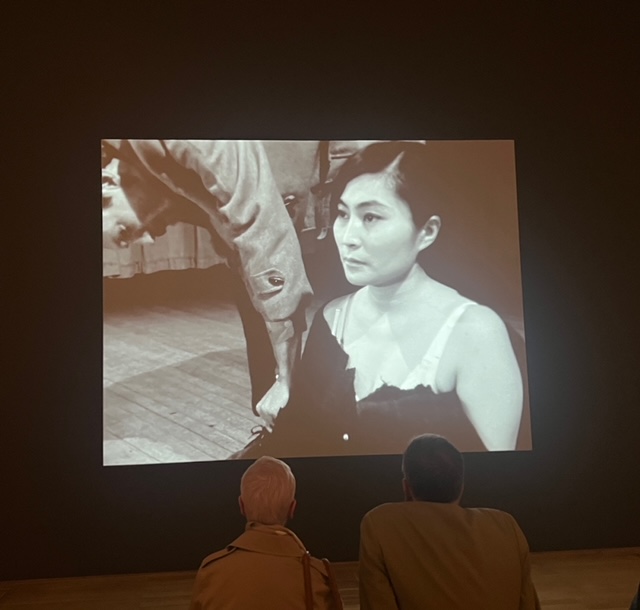Landscapes of the Mind – Thresholds at Gallery of Hermosa
Nancy Kay Turner
Look deep into nature and then you will understand everything.
Albert Einstein
The earth has music for those that listen.
William Shakespeare
Thresholds, thoughtfully curated by Genie Davis, brings together five artists, Eileen Oda Leaf, Hung Viet Nguyen, Angelica Sotiriou, Linda Sue Price, and Snezana Saraswati Petrovic, whose artworks reference the elements of air, water and earth. Working across different mediums such as oil and acrylic painting, mixed-media drawing, neon and 3-D printed sculpture, these artists create landscapes that take us from the depths of underwater reefs to gently rolling hills, jagged mountains, and aerial views of land both icy and green, moving engagingly from the micro to the macro. These five artists present landscape as a state of mind rather than an actual place by creating romantic dreamscapes that are idealized versions of nature.
Both Hung Viet Nguyen and Eileen Oda Leaf invent inviting scenarios, jam-packed with flowers, trees and plants with highly textured surfaces. While Nguyen literally sculpts and incises thickly applied oil paint, creating ridges and crevasses that illuminate his forms in his Sacred Landscape series, Oda Leaf adds actual painted materials to her pieces, as in “Desert Plateau,” laying them out in a regular simplified pattern that recall embroidered Folk Art hangings. Both painters present bucolic unspoiled scenes where the sun always shines, the grass is green, the water is pure and there are rarely people visible. While Nguyen’s paintings focus on the majestic and mysterious, bringing the viewer on a spiritual journey, Oda Leaf’s work focuses on recognizable spots such as piers, desert and forests which she transforms with her lavish color palette. Nguyen and Oda leaf are masterful colorists whose palette and paint handling echo both the Impressionists and the Symbolists.
The sculptors Linda Sue Price and Snezana Saraswati Petrovic use industrial and technological materials such as neon, 3-D printing and augmented reality to create compelling works that challenge our perceptions of the environment. Price’s jaunty neon works evoke both the down to earth world of plants in “Snake Beans” and “Kapeeno,” and aerial views of cities and freeways in “The Other Side of the Story. ” The festive colors and the surprising movement of the neon itself suggests cars moving on a freeway or even the gurgling equipment of a mad scientist, making these works especially lively.
Petrovic’s tiny, jewel-like 3-D printed “Pas De Deux” and “Coral Song” are poetic recreations of coral reefs that the artist not only imagines or re-imagines but ones that she has seen on her many dives. Each delicate translucent piece looks lit from within glowing, lace-like, and seeming to sway. Petrovic, whose works are conceptual, continues her use of 3-D printer technology along with augmented reality in her Sprawling LA series. These two pieces paradoxically look both macro (aerial view) and macro (view of the ocean floor). If one downloads the ARTIVIVE app on one’s smartphone, one can view the AR image that appears over the physical 3-D digital print. A frenetic Los Angeles freeway appears over one landscape and a serene ocean view with a seagull flying in the sky appears over the other. Petrovic alludes here to man’s destruction of the ecosystem and what is being destroyed.
Angelica Sotiriou’s works on paper and canvas are highly abstracted and poetic. Her large- scale mixed media painting “Scala, Divine Ascent,” highlights striations between earth and the heavens that are delineated, moving from earth tones to blue sky and to a glowing beyond. A simplified gold leaf tree reaches upwards towards the stars, perhaps a symbol of growth and transcendence.
Nature is clearly the star in Thresholds – bountiful, fecund, benevolent, a treasure to behold. Humans rarely appear and when they do, they are tiny specks in the immense universe – small and insignificant. They seem newly formed and not yet dangerous to the planet. There are no cars, planes, buses, cruise ships or tourism. This earth is still a paradise, unspoiled and pristine. Clearly a balm for a troubled soul.
And what is the threshold suggested by the title? Is it the precipice we find ourselves on? The tipping point or moving from the now to the point of no return? Is it the portal one steps through from the present into the future, from the known into the unknown? From what could be into what is? Uncertainty swirls about us daily but in this exhibition, Davis offers us beauty, serenity and abundance. Perhaps this is also a gentle call to action – a reminder of what might be lost if we don’t preserve what we have while we still have it.
– Nancy Kay Turner; photos: Nancy Kay Turner, Genie Davis, Dani Dodge
Pasadena, CA.














































































































